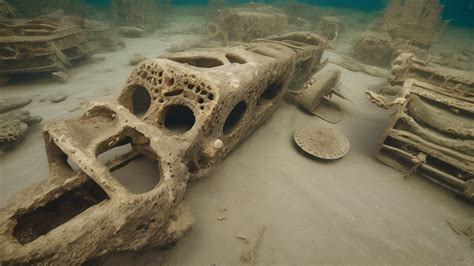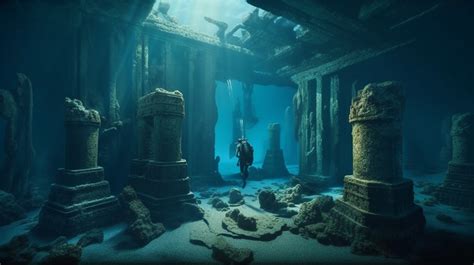
Construction workers in Valencia, Spain, have unearthed six remarkably well-preserved ancient shipwrecks during the expansion of a metro line, revealing a significant maritime history dating back centuries.
Valencia’s urban landscape has yielded an extraordinary archaeological find: six ancient shipwrecks discovered during the ongoing expansion of Metro Line 10. This unprecedented discovery, initially believed to be a single vessel, has transformed into a treasure trove of maritime history, captivating archaeologists and historians alike. The ships, varying in age and origin, offer a rare glimpse into the bustling port activity and trade routes that defined Valencia’s past.
The discovery occurred during excavation work for a new metro station. As construction crews delved deeper into the earth, they encountered the first remnants of what they initially thought was a single wooden hull. Upon closer inspection, archaeologists quickly realized that they had stumbled upon something far more significant: a cluster of six distinct shipwrecks, each with its own unique story to tell.
The find is considered exceptionally rare due to the ships’ state of preservation and the context in which they were found. Urban development often destroys or scatters archaeological remains, making this discovery all the more remarkable. The fact that these ships remained relatively intact beneath the city streets provides an unparalleled opportunity to study ancient shipbuilding techniques, trade practices, and daily life aboard these vessels.
Archaeologists are meticulously excavating and documenting each shipwreck, carefully removing artifacts and analyzing the ships’ construction. The process is painstaking and time-consuming, but the rewards are immense. Each artifact uncovered—from pottery shards and tools to personal belongings of the crew—adds another piece to the puzzle, helping to reconstruct a vivid picture of Valencia’s maritime past.
The ships themselves vary in size, design, and apparent function. Preliminary analysis suggests that they span several centuries, representing different periods of Valencia’s maritime history. Some appear to have been used for cargo transport, while others may have served as fishing boats or even military vessels.
One of the most intriguing aspects of the discovery is the potential for understanding the types of goods that were traded in Valencia during these periods. The ships’ cargo holds may contain remnants of spices, textiles, ceramics, and other commodities that were transported to and from the city. By analyzing these materials, archaeologists can gain insights into Valencia’s economic relationships with other regions of the Mediterranean and beyond.
“This is an exceptional find,” said Dr. Helena Rodriguez, the lead archaeologist overseeing the excavation, as quoted in local news outlets. “The preservation of the ships is remarkable, and they offer a unique opportunity to study maritime life in Valencia over several centuries.”
The discovery has sparked considerable excitement among historians and archaeologists, who see it as a major contribution to our understanding of Mediterranean maritime history. It has also generated considerable public interest, with local residents eager to learn more about the ships and their stories.
The excavation and analysis of the shipwrecks are expected to continue for several months, if not years. The archaeologists are working closely with local authorities to ensure that the discovery is properly preserved and that the public has opportunities to learn about it. Plans are being made to display some of the artifacts in local museums, allowing visitors to experience Valencia’s maritime past firsthand.
The discovery of the shipwrecks has also raised questions about the future of the metro line expansion. While the project is important for improving transportation in Valencia, it is also essential to protect and preserve the city’s cultural heritage. The local authorities are working to find a balance between these competing interests, ensuring that the metro line can be completed without causing further damage to the archaeological site.
In the meantime, the shipwrecks remain a testament to Valencia’s rich maritime history, a reminder of the city’s long and enduring connection to the sea. They offer a unique window into the past, allowing us to glimpse the lives of the sailors, traders, and fishermen who once sailed these waters. As the excavation continues, more secrets are sure to be revealed, further enriching our understanding of Valencia’s fascinating past.
The discovery underscores the importance of archaeological research and the need to protect cultural heritage sites, even in the midst of urban development. It also highlights the potential for unexpected discoveries to be made beneath our feet, reminding us that the past is always present, waiting to be uncovered. The ongoing excavation promises to yield even more valuable insights into Valencia’s maritime history, making this discovery a truly remarkable event.
The find is particularly significant given the historical context of Valencia as a major Mediterranean port. Throughout its history, Valencia has served as a crossroads for trade and cultural exchange, connecting Europe with North Africa and the Middle East. The city’s strategic location on the coast has made it a vital hub for maritime activity, attracting merchants, sailors, and adventurers from all corners of the world.
The shipwrecks discovered during the metro line expansion provide tangible evidence of this rich maritime heritage. They offer a glimpse into the ships that once frequented Valencia’s port, the goods they carried, and the people who sailed them. By studying these ships, archaeologists can learn more about the economic, social, and cultural forces that shaped Valencia’s past.
The preservation of the shipwrecks is also a testament to the unique environmental conditions that prevailed at the site. The soil in Valencia is particularly conducive to the preservation of organic materials, such as wood. This, combined with the fact that the ships were buried deep beneath the city streets, helped to protect them from the elements and from human interference.
The discovery of the shipwrecks is not only important for understanding Valencia’s maritime history, but also for understanding the history of shipbuilding in the Mediterranean. The ships represent different periods and styles of shipbuilding, providing valuable insights into the evolution of maritime technology. By studying the ships’ construction, archaeologists can learn more about the tools, techniques, and materials that were used to build them.
The discovery has also sparked a renewed interest in Valencia’s maritime heritage among local residents. The city has a long and proud maritime tradition, but much of this history has been forgotten or overlooked in recent years. The discovery of the shipwrecks has helped to rekindle interest in this history, and to remind people of Valencia’s enduring connection to the sea.
The local authorities are working to capitalize on this renewed interest by developing new tourism initiatives that showcase Valencia’s maritime heritage. Plans are being made to create a maritime museum, which would house the artifacts recovered from the shipwrecks and tell the story of Valencia’s maritime past. The museum would be a major attraction for tourists, and would help to promote Valencia as a cultural destination.
The discovery of the shipwrecks is a reminder that urban development can sometimes lead to unexpected discoveries. While construction projects can often damage or destroy archaeological sites, they can also uncover hidden treasures that shed new light on the past. It is therefore important to ensure that archaeological research is integrated into urban development projects, so that these discoveries can be made and properly studied.
The excavation of the shipwrecks is a complex and time-consuming process, but it is also a rewarding one. Each artifact uncovered, each piece of wood analyzed, brings us closer to understanding Valencia’s maritime past. As the excavation continues, more secrets are sure to be revealed, further enriching our understanding of this fascinating city and its enduring connection to the sea. The team of archaeologists, historians, and conservators are working diligently to ensure that the shipwrecks are properly documented, preserved, and studied. Their work will provide valuable insights into Valencia’s maritime past for generations to come.
The find has also prompted discussions about the importance of preserving archaeological sites in urban environments. Balancing development with the preservation of cultural heritage is a challenge faced by cities around the world. The Valencia discovery serves as a reminder that these two goals are not mutually exclusive. With careful planning and collaboration, it is possible to develop cities while also protecting and celebrating their rich history. The local government is now considering implementing stricter regulations regarding construction near historically significant areas to prevent accidental damage to future discoveries.
Moreover, the discovery is not just of local significance; it has implications for our understanding of global trade routes and maritime technology during the periods the ships represent. Analysis of the ships’ construction and cargo can provide crucial data for comparative studies with other shipwrecks found across the Mediterranean and beyond. This contributes to a broader, more nuanced picture of maritime history and the interconnectedness of different cultures and economies. The collaborative nature of the archaeological work, involving experts from various institutions and countries, highlights the international importance of the find.
The discovery also highlights the importance of interdisciplinary collaboration. Archaeologists, historians, marine biologists, and other experts are working together to analyze the shipwrecks and their contents. This collaborative approach is essential for understanding the full significance of the discovery. The different disciplines bring unique perspectives and expertise to the table, allowing for a more comprehensive and nuanced interpretation of the evidence. The ongoing research will likely generate numerous publications and presentations, contributing to the scholarly literature on maritime history and archaeology.
The long-term preservation of the shipwrecks and their artifacts is a significant undertaking. The wooden hulls are fragile and require specialized conservation techniques to prevent them from deteriorating further. The artifacts also need to be carefully cleaned, documented, and stored to ensure their long-term survival. The local government is committed to providing the resources necessary for this preservation effort. They are also exploring options for displaying the shipwrecks and their artifacts in a way that is both informative and engaging for the public.
The discovery also has the potential to inspire future generations of archaeologists and historians. The shipwrecks provide a tangible link to the past, and they can help to spark an interest in history and archaeology among young people. The local schools are planning field trips to the excavation site, and the archaeologists are giving presentations to students about their work. This outreach effort is aimed at fostering a sense of curiosity and wonder about the past, and at encouraging young people to consider careers in archaeology and related fields.
In addition to the scientific and educational value of the discovery, it also has significant economic potential. The shipwrecks are likely to become a major tourist attraction, drawing visitors from around the world to Valencia. This will boost the local economy and create new jobs in the tourism sector. The local government is working to develop tourism infrastructure and marketing strategies to maximize the economic benefits of the discovery.
The discovery of the shipwrecks in Valencia is a remarkable event that has captured the imagination of people around the world. It is a testament to the power of archaeology to reveal hidden secrets and to connect us with the past. The ongoing excavation and analysis of the shipwrecks promise to yield even more valuable insights into Valencia’s maritime history, making this discovery a truly significant contribution to our understanding of the human story. The find serves as a powerful reminder of the importance of preserving our cultural heritage for future generations.
The complexity of the find necessitates a phased approach to excavation and analysis. Initially, the focus is on carefully documenting the location and condition of each shipwreck. This involves creating detailed maps, taking photographs, and collecting samples for analysis. Once the initial documentation is complete, the archaeologists begin the painstaking process of excavating the shipwrecks. This involves carefully removing the soil and debris that surrounds the ships, and documenting any artifacts that are found. The artifacts are then taken to a laboratory for further analysis and conservation.
The analysis of the shipwrecks involves a wide range of scientific techniques. Wood samples are analyzed to determine the age and species of the trees that were used to build the ships. This information can help to determine the origin of the ships and the trade routes that they traveled. The artifacts are also analyzed to determine their age, origin, and function. This information can provide insights into the daily lives of the people who sailed on the ships and the goods that they traded.
The conservation of the shipwrecks is a challenging task. The wooden hulls are fragile and susceptible to decay. The archaeologists are working to stabilize the hulls and to prevent them from deteriorating further. This involves applying special chemicals and coatings to the wood, and storing the hulls in a controlled environment. The artifacts are also conserved to prevent them from deteriorating. This involves cleaning the artifacts, repairing any damage, and storing them in a safe and secure location.
The discovery of the shipwrecks has generated a great deal of excitement among the local community. The people of Valencia are proud of their maritime history, and they are eager to learn more about the shipwrecks. The local government is working to keep the community informed about the progress of the excavation and analysis. They are also organizing public events to allow people to see the shipwrecks and to learn about their history.
The discovery of the shipwrecks in Valencia is a significant event that has the potential to transform our understanding of maritime history. The ongoing excavation and analysis of the shipwrecks will provide valuable insights into the lives of the people who sailed on these ships and the goods that they traded. The discovery is also a reminder of the importance of preserving our cultural heritage for future generations. The meticulous work being undertaken by the archaeological team is ensuring that the stories of these ancient vessels will be told for years to come.
The discovery also serves as a catalyst for further research into Valencia’s past. Historians and archaeologists are now revisiting old records and archives, searching for clues that might shed more light on the shipwrecks and the maritime activity that took place in Valencia centuries ago. This renewed interest in the past is enriching our understanding of Valencia’s history and its place in the broader Mediterranean world. The find has not only unearthed physical artifacts, but also sparked a renewed intellectual curiosity about the city’s origins and development.
The ethical considerations surrounding the excavation and preservation of the shipwrecks are also paramount. The archaeologists are committed to ensuring that the excavation is conducted in a responsible and ethical manner, respecting the integrity of the site and the cultural heritage that it represents. They are also working to ensure that the shipwrecks are properly preserved for future generations, so that they can continue to learn from them. The commitment to ethical practices underscores the importance of responsible stewardship of cultural heritage resources.
The discovery has also prompted a reassessment of the potential for further archaeological finds in Valencia. The city has a long and rich history, and it is likely that there are many other undiscovered archaeological sites beneath its streets. The local government is now considering implementing a more comprehensive archaeological survey of the city, to identify and protect these sites. This proactive approach to archaeological preservation will help to ensure that Valencia’s cultural heritage is protected for future generations.
The impact of the discovery extends beyond the academic and cultural spheres. It also has implications for urban planning and development. The local government is now taking archaeological considerations into account when planning new construction projects. This will help to prevent future damage to archaeological sites, and to ensure that any discoveries are properly documented and preserved. The integration of archaeological considerations into urban planning is a key step towards responsible and sustainable development.
The collaboration between the archaeological team and the construction workers involved in the metro line expansion has been crucial to the success of the project. The construction workers were trained to recognize potential archaeological finds, and they were instructed to stop work immediately if they encountered anything suspicious. This collaboration helped to ensure that the shipwrecks were discovered and properly protected. The success of this collaboration highlights the importance of communication and cooperation between different stakeholders in urban development projects.
The discovery of the shipwrecks in Valencia is a testament to the enduring power of the past to surprise and inspire us. It is a reminder that history is not just something that we read about in books, but something that is all around us, waiting to be discovered. The ongoing excavation and analysis of the shipwrecks will continue to reveal new insights into Valencia’s maritime past, and to enrich our understanding of the human story. The find serves as a powerful reminder of the importance of preserving our cultural heritage for future generations. The unearthed vessels are not just ancient ships; they are time capsules that connect us to the lives, dreams, and struggles of those who came before us. Frequently Asked Questions (FAQ)
1. Where were the shipwrecks discovered?
The shipwrecks were discovered in Valencia, Spain, during the expansion of a metro line, specifically Metro Line 10.
2. How many shipwrecks were found?
Six ancient shipwrecks were unearthed during the construction work. This was more than initially expected when the first remnants were discovered.
3. How old are the shipwrecks?
The exact ages of the shipwrecks are still being determined, but preliminary analysis suggests that they span several centuries, representing different periods of Valencia’s maritime history. They offer a glimpse into the city’s past through various eras.
4. What is the significance of this discovery?
The discovery is significant because it provides a rare and remarkably well-preserved insight into Valencia’s maritime history, shipbuilding techniques, trade practices, and daily life aboard these vessels over several centuries. The wrecks offer tangible evidence of Valencia’s role as a major Mediterranean port.
5. What will happen to the shipwrecks and artifacts?
The shipwrecks are being meticulously excavated and documented. Artifacts are being analyzed and preserved. Plans are underway to display some of the artifacts in local museums, providing the public with access to Valencia’s maritime past. The preservation efforts ensure that future generations can learn from these historic finds.









